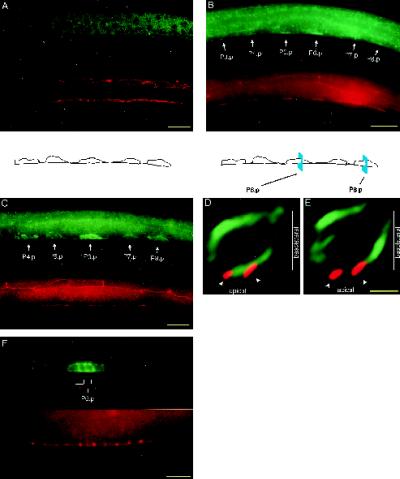Figure 1.
Localization of LET-23 RTK in vulval epithelial cells. Vulval precursor cells are stained with anti-LET-23 antibodies (green) and a cell junction mAb marker (MH27, red). (A) let-23(sy5) rol-6(e187); lin-1(sy254) mutant shows no specific LET-23 staining. (B) Lateral view of an early L2 wild-type hermaphrodite. Strong LET-23 staining is observed in the apical membrane domain, which appears as a thin line along the ventral surface. Weak LET-23 staining is observed in the basolateral membrane domain, located dorsal and anterior to the cell junctions. At this stage, the cell junctions are small, separate rings that appear as lines when seen on edge. (C) Lateral view of a late L2–early L3 wild-type hermaphrodite. LET-23 staining appears in the basolateral membrane domains of the vulval precursor cells. Cell junctions have elongated along the anterior–posterior axis, such that the junction from one vulval precursor cell connects with the junctions from adjacent vulval precursor cells. (D and E) Optical cross-sections of vulval precursor cells P6.p (D) and P8.p (E) from a late L2–early L3 wild-type hermaphrodite. The basolateral membrane domain is above the cell junctions, and the apical membrane domain is between or slightly below the cell junctions. LET-23 appears predominantly basolateral in P8.p and both basolateral and apical in P6.p. Outlines of the vulval precursor cells depicted in C and of the cross-sectional areas depicted in D and E are shown. Cross-sections were generated by rotating three-dimensional images 90° about the dorsal–ventral axis and projecting 1 μm along the anterior–posterior axis. (F) Lateral view of an L3 wild-type hermaphrodite, showing granddaughter cells of P6.p. LET-23 staining appears in both the apical and basolateral membrane domains. Dorsal is up and anterior is left, except for D and E. Bars, 10 μm (A-C and F); 2 μm (D and E).

